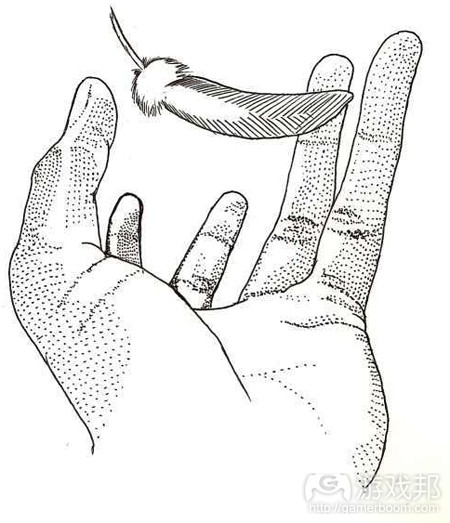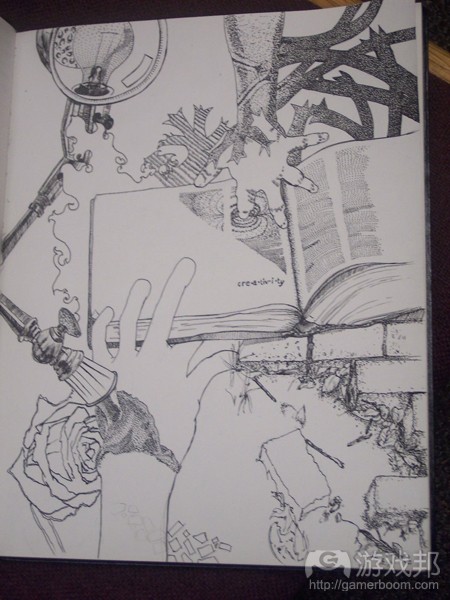理解故事三大元素有助于提高游戏设计水平(1)
作者:Richard Terrell
以电子游戏和其他媒介中的故事构建来作为文章的开篇似乎很奇怪。但是,请相信我,故事可能是我们理解这个世界和相互理解的最为重要的工具。我获得了英语相关学位,并且专注于创意写作,所以故事设计是我研究的领域。许多年来,我听过许多人谈论起他们对故事的理解以及故事各个部分所起的作用,但是他们的想法与现实情况偏差甚远。在讨论何谓故事之前,先明白故事的各个部分是很有益的。(点击此处阅读本文第2、第3部分)
为构建起文学评论理论和游戏设计之间的桥梁,我开设了博客Critical-Gaming。我发觉,利用某些我们较为熟悉的东西(游戏邦注:比如说故事),我们可以更容易地理解游戏设计。通过博客,我创造和定义了许多的术语,解释了为何像“优秀”之类的描述完全不准确而且起不到任何作用。我的想法在于剖析游戏设计的每个方面,这样我们就能够更清楚哪些做法能够深化游戏设计,反过来也能让我们明白为何我们会喜欢或者不喜欢游戏的某个方面。我觉得这是种很棒的方法。所以,是时候将这种方法运用于故事中了。
下文将剖析和比较所有类型的故事。虽然我以前提过某些建设性的基本游戏设计理论,但是我相信故事设计要简单得多。我们对故事构建的直觉应该会超出以下观点。如果要理解故事,我们必须先理解三个主要元素:内容、执行和讲述。
内容
故事就是许多事件的集合。在我们探讨更深层次的含义或执行之前,我们必须关注基本细节或内容。
场景。故事发生的地点。场景由宇宙万物、世界、国家、城镇和时间构成。
角色。维基百科对角色的解释是:叙述性或戏剧性艺术作品中所呈现的人物。角色有各种各样的形式。现实主义并非最佳的角色呈现类型。更为重要的反倒是角色能够以与故事相关或对故事有用的方式呈现。
情节。维基百科对情节的解释是:用于描述组成故事的事件的文学术语,这些事件可能以某种样式相互联系,比如存在因果关系或一致关系。动作和冲突是情节中的两大类别。
复杂性/简单性。细节产生复杂的故事。有些故事有着丰富的角色、地点和阐述所有内容的背景故事。有些故事这些元素中的某些方面格外出众。
主题。普遍或抽象想法、信息或道德。中心思想(游戏邦注:不断出现的象征性元素)能够使主题得到发展。
执行
故事不仅仅是细节的集合体。无论采用线性或非线性的形式,事件呈现的方式就是故事讲述或执行。如果执行过于缓慢、过于明显、过于混乱或过快,即便最棒的故事内容也不会产生好的结果。
效能。花较少的精力实现较大的效果。用较少的场景、对话、地点、动作、事件来传播更多的故事内容。情节重复较少便是有效的故事讲述方式。
条理性。可以采用极为简单和直观的故事呈现方式,风格故事并将其重新安排会让故事很难以理解。因为故事讲述是呈现叙事性事件的过程,事件发生的顺序和传播的方式决定了故事的条理性。
步调。短诗歌有情感波动点。短故事通常也有阐述、动作、高潮和结局等小波段。电视剧、小说和其他长篇故事通常包含有数个“波段”。简单地说,步调就是这些波段来去的快速程度以及对剧情的影响程度。
风格/语言。这里所说的最为明显的想法是像英语或日语之类的口头语言。但是,语言还包括会话短语、专业词汇、肢体语言、文化标志、冷笑话以及其他修饰性语言。风格的分类很广,包括所有你认为能够对故事讲述有益的信息传播方式。
媒介。每种媒介都有利有弊。所以,每种媒介都根据自己的优势形成特别的故事讲述方法。尽管这些方法在每种媒介中都能发挥很棒的效果,它们却无法在其他媒介中起到同等作用。
诗歌最著名的是其浓缩性的文字,其中每个标点符号、文字和格式都有其作用。韵律和结构能够创造出分层化的对比和并列。
短故事擅长于呈现亮点和叙事片段。通过对某些关键时刻的选择,可以在相对紧凑的篇幅中传达出丰富的故事波段。
小说是充满许多细节的大型作品。因为有着这么多的文字,小说可以达到诗歌和某些短故事无法实现的高度。小说中的传播会更加直接。通常来说,书写的语言善于勾起人的内省,因为阅读文字可以引发内心的思考。
图片小说、漫画和连环画使用图片的结合来传递信息,并用大量的文字来弥补图片的短处。此类媒介总是能够平衡通过图片呈现和文字讲述的信息。
戏剧和音乐剧使用大量的对话和舞台表演。富有表现力的可视故事讲述很重要。但是,解释性的文字很少使用。
电影和戏剧相同,都专注于可视信息和对话。在视觉呈现方面,电影更具灵活性。多镜头、特殊效果和后期编辑给电影提供了更大的空间。
电子游戏经常借助来源于其他媒介的技术。有些采用的是诗歌、短故事、小说、图片小说化的呈现、戏剧化的表演和类似电影的场景。但是,最强大的媒介来源于各种媒介优势的相互作用。
动态。动态故事讲述并非只存在于电子游戏中。从对冒险书籍的选择到让观众得到发泄的戏剧,动态指的是故事中的可变和互动元素。
讲述
虽然我们可能没有意识到,但是我们总是将故事与我们经历过的其他事情(游戏邦注:尤指其他故事)相比较来评估质量。换句话说,我们正在不断寻找原创故事。一方面我们因熟悉的内容而感到厌烦,另一方面我们渴望得到新的内容。
创造性。许多人对复制产品不厌其烦。好像我们对创造性的价值评价越高,我们就越贬低复制品。所有的艺术都可以被看作是对生活的反映和重组并赋予其新的含义。我们很难对原创性只有10%的故事表示欣赏。我们对故事设计的理解更深,我们就能更好地判断出某个作品的独特性。
系列。许多系列都是由较小的完整故事(游戏邦注:这些故事属于相同的媒介)组成的。我们很自然地以是否与系列路线相符来评估故事的质量。但是,单独考虑某个故事的度量也非常重要。
跨媒体。跨媒体故事讲述是个首先由大学教师Henry Jenkins提出的概念,他在自己的书籍《Convergence Culture: Where Old and New Media Collide》中用此来定义多种媒体形式中的故事讲述。这个想法的核心是各种形式的媒体相互支持,通过为读者提供不同的视角来整体化解释文字。通常来说,这些类型的文字有着丰富的内容和艺术风格,用户需要投入更多的资金理解整个叙事网络。从这点上看,构建跨媒体专属作品就像是在构建包含万物的宇宙。
回响(和谐)
回响/和谐。这可以衡量故事的不同方面(游戏邦注:上文所述故事的组成部分)相互提升的程度。比如,有个名叫“循环”的故事的主题是循环,那么就可以出现以下这些和谐形式:未来的世界不断循环回到之前的时代里。场景是个巨大的正在旋转的空间站。角色是那些害怕重新回到他们已经逃离的生活的罪犯。角色使用飞镖作为武器来战斗。步调和场景进程中含有日夜循环。所有这些元素都与主题很相配。
如果某个故事都不含有上述元素,那么就不是个好故事。我们必须去除寻找那些铸就“差劲故事”细节的习惯。正如游戏设计那样,故事真正的冲击来源于所有小碎片。因为这个过程很复杂,所以关注或把握单一细节或忽略细节只把握整体都不可行。讨论“劣质”故事的更好方式是解释故事的各个层面如何影响或摧毁其优秀品质。(本文为游戏邦/gamerboom.com编译,如需转载请联系:游戏邦)
Story Design pt.1
Richard Terrell
There’s something I highly respect and value that I need to make clear up front. It’s your opinion, your feelings, and your personal story. Seems like a strange way to open an article about the craft of stories in video games and other media. But, believe me, stories are perhaps the most important tool we have for understanding the world and each other.
I have a degree in English with a concentration in creative writing. So, story design is my area of study. Over the years I’ve found that many talk as if they understand what a story is and how its parts work, yet their statements are far from anything substantive. Before one can talk about what a story is, it helps to be clear about the parts of a story.
I started the Critical-Gaming blog by creating a bridge between the theories of literary critique and game design. I figured that starting with something familiar (stories) we could understand game design more easily. From there I created and defined many terms and explained why descriptors like “good” are utterly imprecise and unhelpful. The idea is by breaking down every facet of game design, we can be more clear about what’s happening design wise, which would in turn shed light on why we like or dislike a particular aspect of a game. I think this is a solid approach. So it’s time to do it again with stories.
The following is a universal system to break down and compare all types of stories. While I’ve come up with some revolutionary and radical game design theories in the past, I believe tackling story design will be much simpler. Our intuitions about the craft of storytelling should go a long way here. So, be patient if it all seems somewhat obvious.
To best understand stories, we must understand three main categories: content, execution, and discourse.
CONTENT
A story is nothing more than a series of events. Before we worry about deeper meaning or execution, we must focus on the fundamental details or the content.
Setting. The place where the story is set. Everything from the universe, world, country, town, and time period make up the setting.
Characters. “The representation of a person in a narrative or dramatic work of art” wiki. Flat, round, foil, realistic, absurd, lead, support, human, animal, ethereal; Characters come in all varieties. Realism is not best type of character. Rather, being relatable or functional to the story are qualities that can be just as, or more, important.
Plot. “A literary term for which the events that make up a story, particularly as they relate to one another in a pattern, a sequence, through cause and effect, or by coincidence” wiki. Action and conflict are two categories that can fit inside plot.
Complexity/Simplicity. Details create complex stories. Some tales are rich with many characters, locations, and back stories about everything. Other stories do very well with very few of these elements.
Theme. General or abstract ideas, messages, or morals. Motifs (reoccuring symbolic elements) can develop the theme.
EXECUTION
Stories are more than a collection of details or a list of qualities. Whether linear or non-linear, how the events are presented is storytelling or execution. If the execution is too slow, too obvious, too jumbled, or too fast even the best story content can fail.
Efficiency. It’s all about doing more with less. Conveying more story content with fewer scenes, lines of dialog, locations, actions, events, and fewer repeated scenarios is efficient storytelling.
Coherence. It’s possible to take a completely simple and straight forward story, cut it up, and rearrange it so that it’s incredibly difficult to understand. Since storytelling is the process of presenting narrative events, the order and the delivery shapes how coherent the work is.
Pacing. Small poems can be like emotionally charged snapshots. Short stories tend to feature a small wave of exposition, action, climax, and resolution. Long running series, novels, and others large stories generally contain multiple “waves.” How quickly these waves come and go and how steep they are is a simple way to think of pacing.
Style/Language. On first thought, the obvious idea here is verbal languages like English or Japanese. But there are also colloquial terms, lexicon, body language, cultural symbols, inside jokes, and other examples that qualify. Style is very broad category. Any way you of conveying information that you can think of can contribute to the style of storytelling.
Medium. Every medium has pros and cons. As a result, every medium has developed particular methods of storytelling based on their strengths. While these methods work great for each medium, they tend not to work so well in others.
Poetry excels in concentrated text where every punctuation, letter, and formatting decision matters. Rhythm and form help to create layered contrast and juxtaposition.
Short stories do well presenting snapshots and slices of narrative. By selecting a few key moments, rich story waves can be conveyed in a relatively compact space.
Novels are large works filled with many details. With so much text, writing to the fine degree that poems and some shorts stories feature isn’t practical. The delivery in novels tends to be more direct. (In general, written language excels at introspection because reading text mimics inner thought).
Graphic Novels/Manga/Comics use a combination of images to convey information and blocks of text to where the images fall short. There’s always a balance between whether information will be shown or told.
Plays/Musicals use lots of dialog and staging (positioning). Expressive, visual storytelling is important. Also, explanatory or expository text is sparingly used.
Films/Movies are similar to plays in that they focus on visuals and dialog. Films have a lot more flexibility when it comes to visual presentation. Multiple cameras, special effects, and editing give films the edge.
Video games often borrow technqiues from other mediums. Some offer poetry (Braid), short stories (Lost Odyssey), novels (Wow? Halo? Mass Effect, Ni No Kuni), graphic novel like presentation (XIII, Metal Gear Acid, inFAMOUS), play like performances (Facade, FF6), and movie like scenes (Heavenly Sword, GTA4, Metal Gear Solid 4). Some pull it off better than others. But ultimately, the strength of the medium comes from interactivity.
Dynamic. Video games aren’t the only source for dynamic storytelling. From choose your own adventure books to plays that work off the audience, dynamics refers to how the variable/interactive elements of a story.
DISCOURSE
Though we may not do it consciously, we’re always evaluating the quality of a story based on how it compares to everything else we’ve experienced (especially other stories). In other words, we’re constantly looking for originality. On the one hand we’re drawn toward the familiar. Yet, on the other we crave the new. It’s a tricky line that most of us don’t realize we walk.
Creativity. Many people are turned off by copycats. It seems that the higher we value creativitiy, the more we devalue replicas. All art can be thought of as the reflection, repacking, and repurposing of life (which includes art). It can be hard appreciating a story for its 10% creativity when you’ve seen the other 90% before in another work. The better we understand the design of stories, the better we can determine how unique one work is to another.
Series. Many series are a collection of smaller complete stories (within the same medium). Naturally, we evaluate the quality of later entries by how they keep in line with the series. However, it’s important to consider the merits of a story as an individual entry.
Transmedia. Danielprimed puts it best: “Trans-media storytelling is a concept first put forward by academic Henry Jenkins in his book Convergence Culture: Where Old and New Media Collide to define storytelling told over multiple forms of media. The crux of the idea is that each form of media supports the others and provides the reader with different, medium-specific viewpoints in which to interpret the text as a whole. Naturally, these types of texts are rich in content and artistic styles, commanding a dedicated user base who are required to spend more money to invest in the entire narrative web. In this regard, building a trans-media franchise is like building a universe.”
Resonance (Harmony)
Resonance/Harmony. This is a measure of how well different facets of a story (listed above) enhance each other. For example, if there’s a story called Cycles and the theme is cycles there could be harmony in the following ways: The conceit is of a futuristic world that slowly phases through time cycling back to previous years. The setting is a giant space station ring that spins in place. The characters are criminals afraid of relapsing back into the life they run away from. The characters battle with boomerangs like weapons. The pacing and scene progression runs on a cyclical day/night cycle. All of these elements would resonate or harmoize nicely with the theme.
If a story has one of these elements great. If it doesn’t, it’s no big deal. One habit that we must move away from is looking for the details that make a “bad story.” Like with game design, the real impact of a story emerges from all of the smaller pieces. Because this process is so complicated, it not very helpful or accurate to look at an individual detail, or lack of a detail, then judge the whole. A better way to discuss “bad” stories is to explain how various facets actually undermine or deconstruct its better qualities. More on this later. (Source: Gamasutra)
上一篇:游戏化适用各个领域 丰富体验内容
下一篇:游戏机制中的惊喜元素不可或缺









































 闽公网安备35020302001549号
闽公网安备35020302001549号